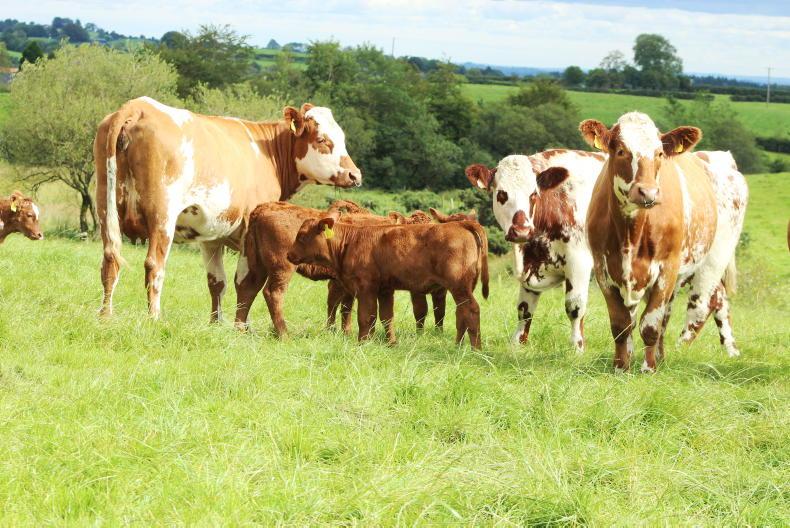Autumn calving is likely to start on many suckler farms around early August, which is five to six weeks away from this weekend.
Therefore, thoughts should be turning to calving preparations, helping to get the next crop of calves up and running.
Outlined below are some things to consider for autumn calving herds:
1. Offer cows pre-calving minerals
Offer cows pre-calving minerals from late June onwards, especially in herds where cows have high levels of milking potential to reduce the risk of milk fever.
Pre-calving minerals can also prevent cows holding the placenta after calving, as well as improving calf vigour at birth. This is a big advantage if cows are allowed to calve outdoors.
2. Grazing
As autumn cows tend to graze up until calving starts, they will be fit and usually encounter fewer problems compared to spring cows penned on slats for six months before calving.
That said, autumn calving cows within the final two months of pregnancy still need to be carefully managed at grass.
Keep cows on low quality grass to prevent cows getting overweight and stop the unborn calf getting too big.
Target older swards, or rough grazing. Strip grazing can also help control intakes.
3. Controlling flies to prevent mastitis
Summer mastitis can be a huge problem with autumn-calving herds and can be difficult to keep on top of.
Common ways to reduce the risk include fly-repellent pour-ons, garlic lick buckets and fly-repellent ear tags.
More often than not, many farmers find a combination of two or all three options work best. Late weaning can also be an option, with calves left on cows up to one month before calving time.
If cows are grazing swards that have gone to seed, fly activity can be increased. Topping may be required with cows cleaning up the clippings.
Finally, keep dry cows away from heavily wooded areas and stagnant water courses.
4. Stock up on calving aids
Don’t get caught out by a cow calving ahead of her time. Stock up on calving aids at some point in the next fortnight.
Purchase calving lubricants, iodine, gloves, electrolytes, scour tablets, colostrum and a new stomach tube if the old one is dirty or scuffed in any way.
Check through the medicine cabinet. Replace antibiotics used to treat infections post-calving, calcium to combat milk fever and pain relief in case of a difficult labour.
Locate the calving jack and ropes. Invest in new ropes if the current set are frayed or hard. Store where they can be easily located in an emergency. Finally, re-order ear tags.
5. Building covers for grazing post-calving
Around mid-July, try and close up a few paddocks to build grass for autumn cows after they calve.
Silage aftermath is ideal for and will help drive milk production, but as such swards are low in fibre, magnesium supplementation is crucial.
Read more
Exclusive: cull cow scheme to cost farmers millions
Sheep prices on the way up - Bord Bia
Autumn calving is likely to start on many suckler farms around early August, which is five to six weeks away from this weekend.
Therefore, thoughts should be turning to calving preparations, helping to get the next crop of calves up and running.
Outlined below are some things to consider for autumn calving herds:
1. Offer cows pre-calving minerals
Offer cows pre-calving minerals from late June onwards, especially in herds where cows have high levels of milking potential to reduce the risk of milk fever.
Pre-calving minerals can also prevent cows holding the placenta after calving, as well as improving calf vigour at birth. This is a big advantage if cows are allowed to calve outdoors.
2. Grazing
As autumn cows tend to graze up until calving starts, they will be fit and usually encounter fewer problems compared to spring cows penned on slats for six months before calving.
That said, autumn calving cows within the final two months of pregnancy still need to be carefully managed at grass.
Keep cows on low quality grass to prevent cows getting overweight and stop the unborn calf getting too big.
Target older swards, or rough grazing. Strip grazing can also help control intakes.
3. Controlling flies to prevent mastitis
Summer mastitis can be a huge problem with autumn-calving herds and can be difficult to keep on top of.
Common ways to reduce the risk include fly-repellent pour-ons, garlic lick buckets and fly-repellent ear tags.
More often than not, many farmers find a combination of two or all three options work best. Late weaning can also be an option, with calves left on cows up to one month before calving time.
If cows are grazing swards that have gone to seed, fly activity can be increased. Topping may be required with cows cleaning up the clippings.
Finally, keep dry cows away from heavily wooded areas and stagnant water courses.
4. Stock up on calving aids
Don’t get caught out by a cow calving ahead of her time. Stock up on calving aids at some point in the next fortnight.
Purchase calving lubricants, iodine, gloves, electrolytes, scour tablets, colostrum and a new stomach tube if the old one is dirty or scuffed in any way.
Check through the medicine cabinet. Replace antibiotics used to treat infections post-calving, calcium to combat milk fever and pain relief in case of a difficult labour.
Locate the calving jack and ropes. Invest in new ropes if the current set are frayed or hard. Store where they can be easily located in an emergency. Finally, re-order ear tags.
5. Building covers for grazing post-calving
Around mid-July, try and close up a few paddocks to build grass for autumn cows after they calve.
Silage aftermath is ideal for and will help drive milk production, but as such swards are low in fibre, magnesium supplementation is crucial.
Read more
Exclusive: cull cow scheme to cost farmers millions
Sheep prices on the way up - Bord Bia






 This is a subscriber-only article
This is a subscriber-only article










SHARING OPTIONS: